|
Success criteria provides clarity to both teachers and students about what is to be achieved during a sequence of learning. As Nick Hart explains 'in most situations, it is better to have clarity rather vagueness'. Which is reason enough for success criteria to exist in most, if not all, lessons. Clarity helps students understand what is expected of them and guides them towards achieving learning objectives or intentions - whatever you like to call it. However, picture being sat in the car on your first day of your driving lessons and being told that today's objective is to find the 'biting point'. For many driving novices, this objective will mean nothing without context. In contrast, if the instructor sits in the driving seat, pushes down on the accelerator, and lifts the clutch slightly so that the car leans forward, and then says, "Today, you are going to learn how to do this," we have clarity! Too often, success criteria are shared with little context or meaning for students who are most probably novices in the subject that we are teaching. By presenting success criteria in a more dynamic and relevant medium, meaning can be made and links can be made to prior learning. Success criteria need to be made domain, subject, and age group specific. It is well worth thinking carefully about this when planning lessons. Open or Closed Success Criteria?Success can sometimes be closed. You either get it or you don't. Closed success criteria usually revolve around the acquisition of knowledge or a skill. You can either add using column addition or you can't. Therefore, success criteria are most relevant in the medium of a series of statements, a list of instructions, or a series of steps. However, sometimes success is open to interpretation. It is qualitative. The impact a child is making on the reader when writing is subjective. Assessing the choices of language will be based upon the age of the child and the context of the genre and style of writing. Similarly, identifying what success looks like for children participating in a game of football will depend upon the position they play, their opposition, and again the age and context of the team. There are multiple ways to be successful. Success criteria in these scenarios may be shared in the style of checklists, toolkits, or menus. So, success criteria should look different depending on what success looks like in that subject or domain. But success criteria also need to be accessible and traditionally it never really has been... Traditional Success Criteria Traditional success criteria is perhaps the lethal mutation of success criteria. It is the format that countless teachers have been forced to add to the first slide for every lesson or perhaps stick in the book of each class member, never to be seen or referred to again. However, there are times when there may be benefits to the traditional success criteria. They do provide instructions that guide students in their learning process. This might include directives and outline expectations of different levels of success. They work well when success is closed. The traditional success criteria are straightforward and easy to follow, making them perfect for tasks that require specific outputs. But, timeliness is key! If they are recorded and outlined alongside examples or models, there may be value. If they are imposed upon class members before they have a clue about the content in which they are trying to succeed in, you are wasting your time. You can't build a snowman if you have never seen snow. Verbal Success Criteria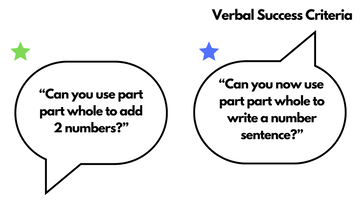 Orally communicated expectations may be all that is needed. For instance, a teacher might ask, "Can you use part part whole to add 2 numbers?" or "Can you now use part part whole to write a number sentence?" This method can be particularly effective for children in the early years of education, or in situations where written criteria may not be appropriate or feasible. If you are launching rockets on the school field, no teacher wants to be wheeling out a whiteboard for the sake of sharing traditional success criteria with the class. This would be both boring and an enthusiasm killer! Stepped Success Criteria Sticking to closed learning, stepped success criteria breaks down a task into smaller, more manageable parts. This can be particularly useful for complex tasks or for students who may struggle with larger tasks. It takes working memory into account and makes success criteria both explicit and useful as a scaffold to follow. For instance, a task might be broken down into creating a simple simile, using ambitious vocabulary within the simile, and then explaining how the chosen vocabulary is intended to make the reader feel. This approach makes the task more approachable and less overwhelming. Example and Modeled Success Criteria
Check List Success Criteria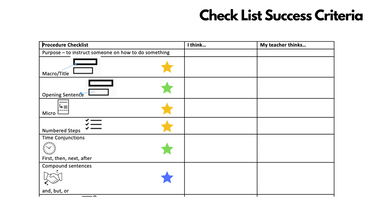 Open-ended success criteria look different. A checklist is a simple but effective method of presenting success criteria that is qualitative. It might include a list of items or tasks that students must complete or tick off. This method is straightforward and allows students to easily track their progress toward the completion of the task, but the danger is it can make creative or qualitative tasks too formulaic. You do not want children ticking off a load of grammatical features during a creative writing session. Imagine an art sketch packed with every style of shading studied in a topic. Hatching, rendering.. scribbling... scumbling... stippling... tick hatching. It would give the parents a headache when stuck to the fridge at home. The value of checklists, menus, and toolkit success criteria is that children are making deeper choices about what success looks like for them in the context of their own learning. Asking children to explain these choices in reference to the toolkit is where the real success lies. Scaffolded Success Criteria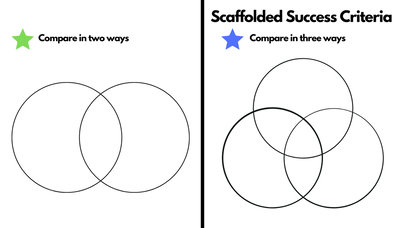 One final style of success criteria I have only more recently seen being used is scaffolded success criteria. This criteria provide students with a structure or framework to complete a task instead of showing a version of the answer. For example, in Science, students might be asked to compare materials in two ways and then in three ways. What I like is that an example of the answer is not revealed, maintaining a sense of discovery to the lesson while also providing support for the process. However, the emphasis on what success looks like could be lost. Importance placed on the learning could be weakened by a greater emphasis on the activity. In the context of the example above, students may focus more on the use of a Venn diagram instead of the properties of different materials. Nevertheless, I wanted to include it as the idea of sharing success through approach still holds some form of value. Planning success criteria should be a carefully thought out process and considering the medium in which success criteria is shared should be part of this. It is also worth noting that, as Bruce Robertons also suggests, sometimes there are benefits in using a combination of approaches too. Making success criteria as accessible and relevant as possible is only going to enhance the student experience. Which one will you try?
0 Comments
Leave a Reply. |
SearchWith a keen interest in the neuroscience and psychology of learning, WAGOLL Teaching is about sharing research alongside great, simple teaching ideas to a global teaching community.
Ben has been in education for over 10 years and is passionate about simplifying high quality teaching and learning through innovative and practical approaches in the classroom. sUBSCRIBE |
|
Who are we? |
With a keen interest in the neuroscience and psychology of learning, WAGOLL Teaching is about sharing research alongside great, simple teaching ideas to a global teaching community.
|
All copyright reserved ©.
I would like to remind all visitors to this website that all pages on this site are copyright protected, unless stated. Most importantly, this site is for the use and enjoyment of all children, parents, guardians, carers and teachers who are involved in WAGOLL Teaching. Please use the resources/ideas as you need without replicating them for your own gains.
I would like to remind all visitors to this website that all pages on this site are copyright protected, unless stated. Most importantly, this site is for the use and enjoyment of all children, parents, guardians, carers and teachers who are involved in WAGOLL Teaching. Please use the resources/ideas as you need without replicating them for your own gains.


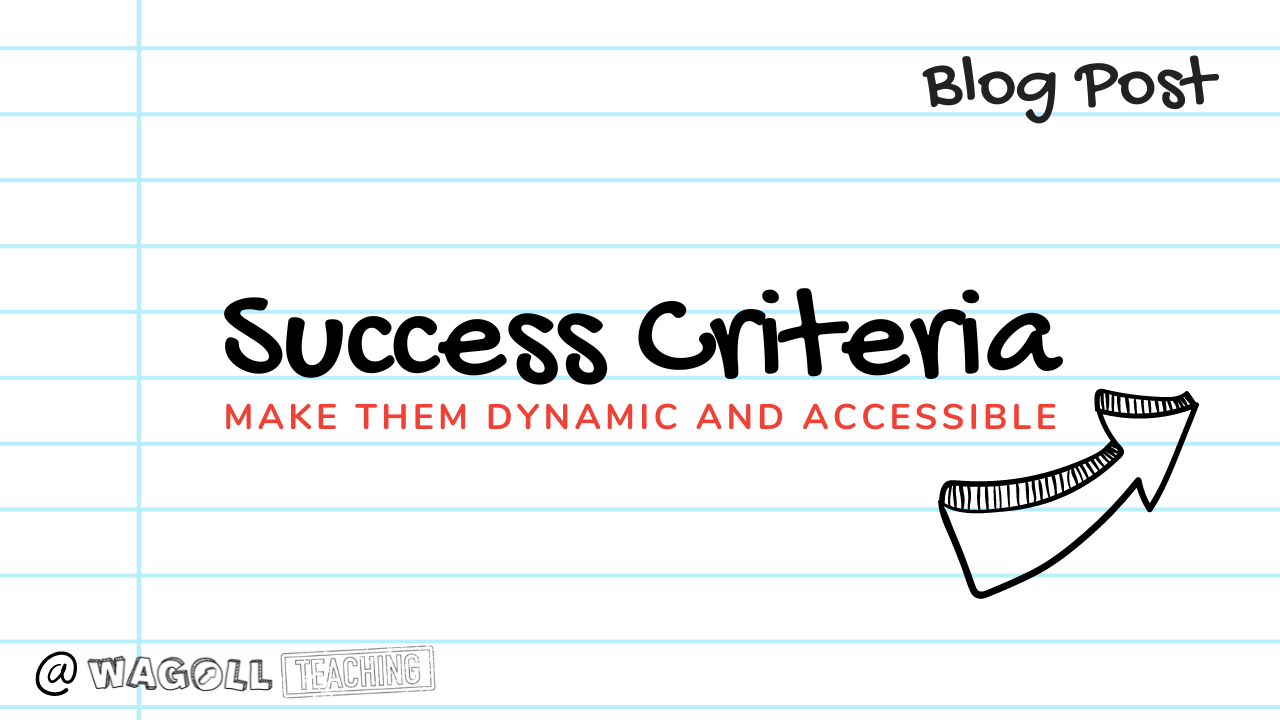

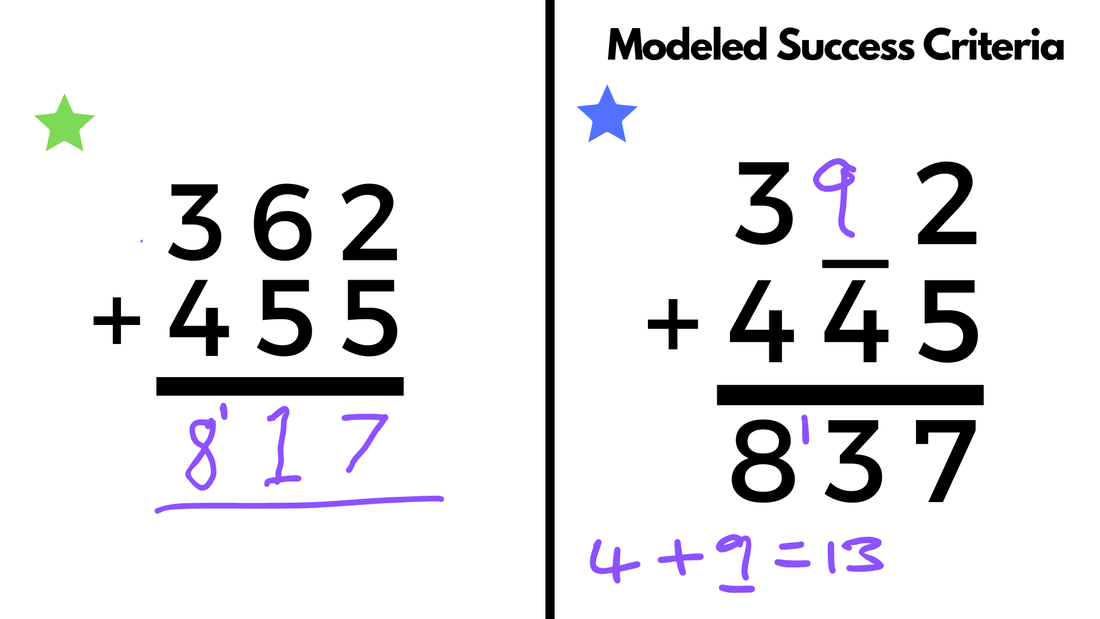




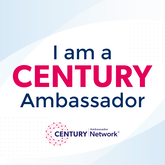

 RSS Feed
RSS Feed


